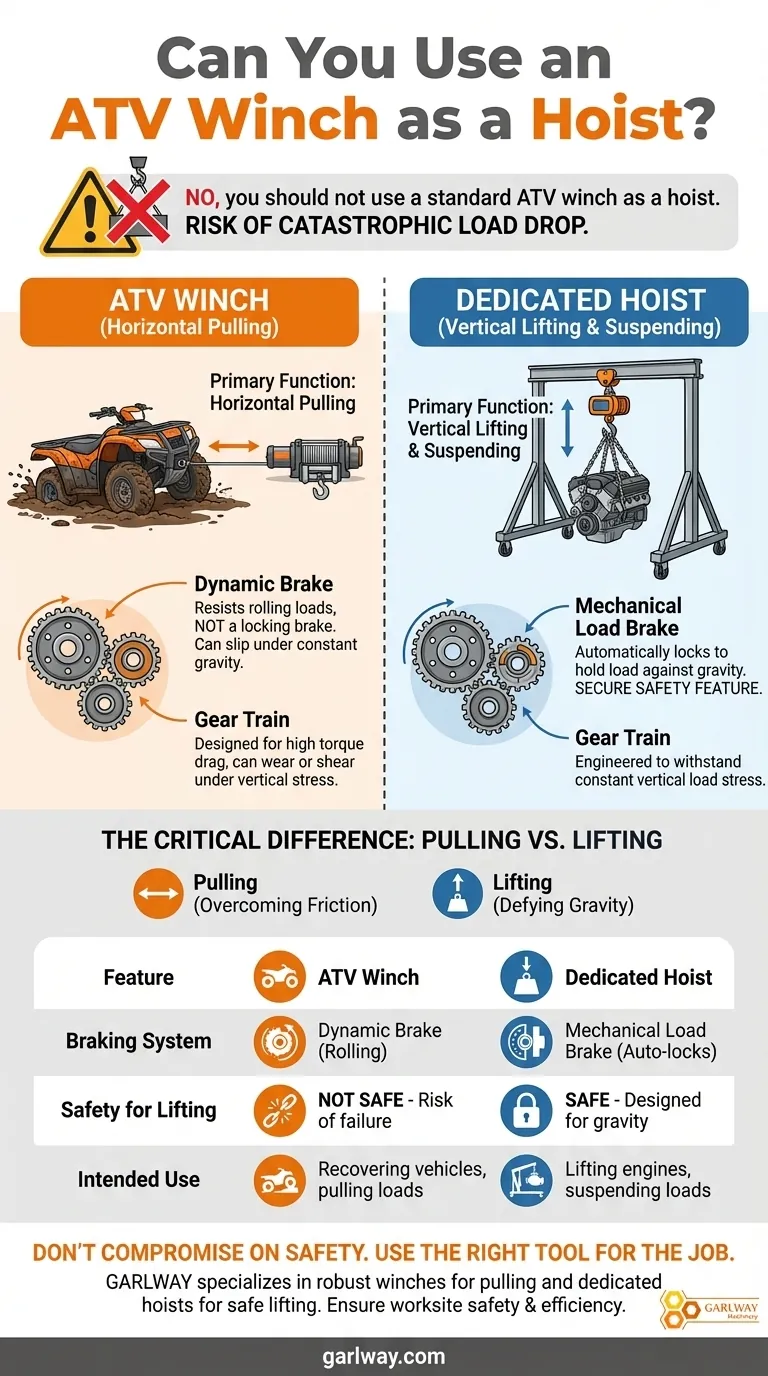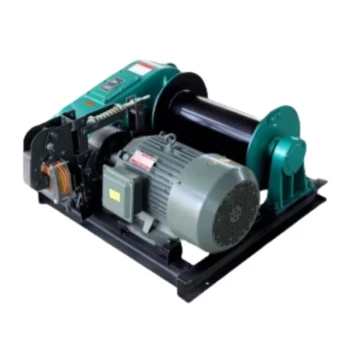No, you should not use a standard ATV winch as a hoist. A typical winch is designed exclusively for the horizontal pulling of a load, not for the vertical lifting and suspending of one. Using it as a hoist introduces a significant risk of gear or brake failure, which could lead to the load catastrophically dropping.
The core issue is the braking system. A hoist has a mechanical brake designed to automatically lock and hold a load against the full force of gravity. A winch has a dynamic brake or simple gear resistance meant only to manage a rolling load, not to safely suspend a dead weight.

The Critical Difference: Pulling vs. Lifting
Understanding why a winch is not a hoist comes down to a fundamental distinction in their design and purpose. One is built to overcome friction, while the other is built to defy gravity.
How a Hoist's Braking System Works
A hoist uses a mechanical load brake. This system is specifically engineered to engage automatically the moment you stop lifting.
The weight of the load itself helps apply pressure to the brake, creating a secure lock that prevents slipping. This is a critical, built-in safety feature for suspending objects.
How a Winch's 'Brake' Is Different
A standard winch uses a dynamic brake. This system is designed to provide resistance and control while the winch is under power, particularly when spooling out cable.
It is not a true locking brake. It cannot be relied upon to hold a suspended load for any length of time, as the gears are not designed for that specific stress and can slip or "creep" under the constant pull of gravity.
The Purpose of the Gear Train
Winch gears are engineered for high torque to drag a heavy, rolling load across a surface. They are not built to withstand the unique, constant, and direct stress of a suspended vertical load.
This mismatch in design can cause the gears to wear down prematurely or even shear off, resulting in complete and sudden failure.
Understanding the Trade-offs and Risks
While it might seem tempting to use the tool you have on hand, the risks associated with misusing a winch for lifting are severe.
The Danger of Catastrophic Failure
The most significant risk is that the winch's gearing or dynamic brake will fail. Unlike a hoist, which is designed with safety factors for vertical lifting, a winch provides no such guarantee.
If the gears slip or break, the load will drop without warning.
Specialized "Winch Hoists" Exist
It's important to note that a special category of tool called a "lifting winch" or "winch hoist" does exist.
These are hybrid devices specifically built for vertical applications and are equipped with the proper mechanical braking and gearing systems found in a hoist. However, a standard ATV winch does not fall into this category.
Why Horizontal Pulling is Different
Pulling a 1,000-pound ATV stuck in the mud requires overcoming rolling resistance and friction, which is a different type of force than lifting a 1,000-pound engine block.
Lifting requires the device to support the entire weight of the object directly against gravity, a constant force that a winch is not designed to safely manage.
Making the Right Choice for Your Task
Choosing the correct tool is not about convenience; it is about safety and preventing catastrophic failure.
- If your primary focus is safety and suspending a load vertically: Always use a dedicated hoist that is rated for the weight you intend to lift.
- If your primary focus is pulling a rolling or sliding load horizontally: A standard ATV winch is the correct and intended tool for the job.
- If you need to lift something and only have a winch: Do not proceed. The only safe action is to acquire the proper lifting equipment for the task.
Ultimately, understanding the fundamental difference between pulling and lifting is the key to ensuring a safe and successful outcome for your project.
Summary Table:
| Feature | ATV Winch | Dedicated Hoist |
|---|---|---|
| Primary Function | Horizontal Pulling | Vertical Lifting & Suspending |
| Braking System | Dynamic Brake (for rolling loads) | Mechanical Load Brake (auto-locks) |
| Safety for Lifting | Not Safe - Risk of gear failure and load drop | Safe - Designed to hold against gravity |
| Intended Use | Recovering vehicles, pulling loads across ground | Lifting engines, materials, suspending loads |
Don't compromise on safety. Use the right tool for the job.
GARLWAY specializes in robust construction machinery, offering reliable winches for horizontal pulling and dedicated hoists for safe vertical lifting. Our equipment is engineered for the demanding needs of construction companies and contractors globally, ensuring performance and safety on every project.
Ensure your worksite safety and efficiency. Contact our experts today to find the perfect lifting or pulling solution for your specific requirements!
Visual Guide

Related Products
- 12000 lb Electric Boat Trailer Winch with Windlass Anchor Warn
- Portable Small Trailer Winch
- Best 18000 Pound Drum Anchor Trailer Winch
- Heavy Duty Electric Boat Winch Windlass Anchor
- Electric Hoist Winch Boat Anchor Windlass for Marine Applications
People Also Ask
- What are important usage tips for trailer winches? Ensure Safe and Efficient Boat Loading
- How are trailer winch sizes determined? Match Capacity to Your Boat's Weight for Safe Loading
- How does using a trailer mounted winch reduce the need for additional equipment? Streamline Your Job Site Logistics
- What is the purpose of a trailer winch? Achieve Safe & Effortless Heavy Loading
- What is the significance of trailer winches in the boating industry? Ensure Safe and Efficient Boat Recovery













